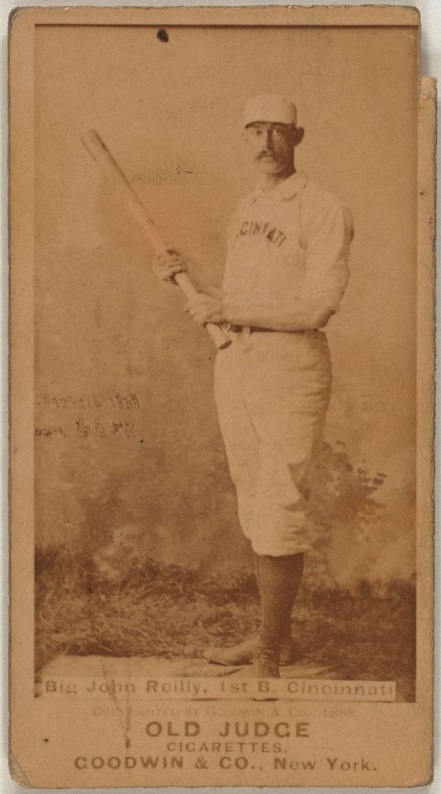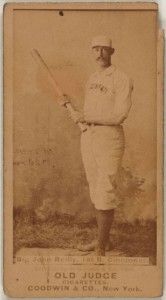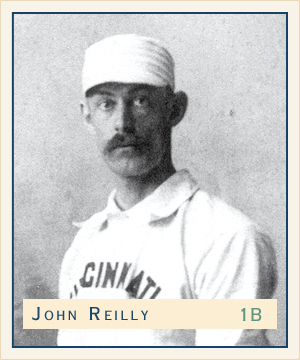Historical Hitter September 19 1883: John Reilly

 On this day back in 1883, Long John Reilly hit the cycle. What is more remarkable is this was the second cycle he hit this week, for hit for the cycle seven days ago on the 12th. He would end his career by being one of just three players to hit for the cycle three times. The three for Big John’s cycles are September 12, 1883; September 19, 1883; and August 6, 1890.
On this day back in 1883, Long John Reilly hit the cycle. What is more remarkable is this was the second cycle he hit this week, for hit for the cycle seven days ago on the 12th. He would end his career by being one of just three players to hit for the cycle three times. The three for Big John’s cycles are September 12, 1883; September 19, 1883; and August 6, 1890.
John was a true “homer.” He was born, breed, bleed and was dead all in Cincinnati Red. Born in the Queen City in 1858, and debuted for the Reds on May 18, 1880, he hung up his spikes on October 3, 1891, and died on May 31, 1937 and buried in Cemetery of Spring Grove in Cincinnati. And for good measure he was enshrined in the Reds Hall of Fame in 2012. He played most of his career next to second baseman and fellow Queen City local, Bid McPhee. His only non-Cincinnati blemish was six months spent as a New York Met in the season of 1882.
His first baseball experience was in Metropolitan Cincinnati across the Ohio River in Kentucky as a 14 year old for the Strobridge Lithograph Company. This experience was instrumental in shaping his life in and after baseball. When John retired he spent the significant part of his adult life as an artist especially known for painting circus murals.
The Reds slugger was a proponent of keeping one’s bat in clean and working order by scraping them with glass. Unlike Willie Keller, Reilly was quoted as not a believer in place hitting. As he told Sporting Life editor : “… no man can hit a good pitcher’s delivery in any direction he pleases.”
At 6-3, Long John was a fixture at first base and a very skilled batter, even if he could not place his hits. He lead the American Association in hits OPS, home runs and slugging percentage. When half of the American Association joined the National League in 1890, John led the league in triples. Despite such prowess in the old American Association, Bill James ranks Big John as the 106th best first baseman ahead of Mets Dave Magadan and Ed Kranpool. Part of the issue might be lack of record keeping and accessible data. Below are excerpts of his two cycles written David Ball in John Reilly’s SABR BioProject article:
On September 12, Cincinnati rolled over the Alleghenys, beginning with a nine-run first inning. Even among a host of impressive offensive performances, Reilly’s line in the box score stood out, with six hits in seven at bats as well as two stolen bases and six runs scored. In the bottom of the eighth, he drove an opposite field line drive to right field to score Carpenter again with Cincinnati’s fourth home run of the game. The hit finished the scoring in a 27-5 victory, and also completed a cycle for Reilly, who had already hit a double and triple to go with his three singles
On September 19, Reilly belted four hits in a 12-3 win and brought his hot streak to a climax by hitting for the cycle for the second time in a week.
Long John’s father had a career on the water. He was a riverboat captain, not a seafood restaurateur, on the Ohio in the romantic age of Mark Twain, and the steam powered riverboats. This experience of being on the river actually helped save his life. On the early morning of June 12 he was fast asleep on the Long Island steamer Narragansett, when it collided with another boat, the Stonington. It was on a dark cloudy night some six miles south of Duck Island near the Connecticut coast. The New York Tribune reported on the calamity.
The entire lower deck was a sheet of flame. The Scene was one of indescribable terror. The cries of terror and distress were agonizing.
John was a hero as one could be in such chaos. He climbed as mast to free a life boat, tried in vain to save a family locked in their stateroom, and then jumped on a plank of wood and floated in the summers tide until he was rescued. The news of the ships sinking got his teammates before the news of his survival, and unconfirmed reports of his death were circulating. The Reds played the next day in Providence and lost 11-4. “The sad news of the loss of John Reilly on the ill-fated Narragansett seemed to have a depressing effect on the Cincinnati’s,” reported the Cincinnati Gazette. Yet these reports were premature, aided by vague reporting. The New York Tribune listed a, “Riley, J Providence, RI,” as surviving. John had survived and was recovering on the docks waiting for a friend to return with some dry clothing. In a few days he rejoined the Reds on their New England road trip to the joy of his teammates, opposing teams’ fans and of course his family back in Cincinnati. While his rescue from a riverboat accident might have been miraculous, there were no miracles on the diamond for these Reds. This 1880 squad was anything but a big red machine during this tumultuous road trip in June they record was 4-20, win number 5 came in Boston on June 17. They ended the season in last place going 21-59.

After his rookie year and escaping the harrowing experience of sinking steamboats, Long John learned the fine art of batting with great aplomb. Three times during this era he hit more than 10 home runs, and during his six year peak he hit .307, averaged 9 home runs with 85 RBI with a 145 OPS+. Best remembered in the Reds Hall of Fame, with the following career summary:
“Long John” Reilly was an extraordinarily talented man and a ballplayer, an accomplished commercial artist and one of the most versatile batsmen of the American Association.”
[divider]
Sources:
Sporting Life Volume 15 Number 19 1890.
Reds Hall of Fame website. http://cincinnati.reds.mlb.com/cin/hof/hof/directory.jsp?hof_id=121037
SABRBioProject by David Ball http://sabr.org/bioproj/person/df50ad73
Baseball-reference.com
Baseball-almanac.com
